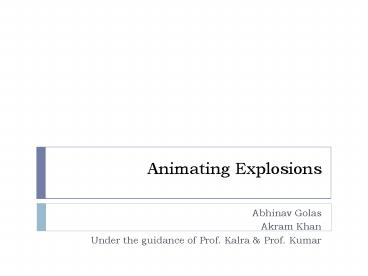Animating Explosions - PowerPoint PPT Presentation
Title:
Animating Explosions
Description:
Animating Explosions Abhinav Golas Akram Khan Under the guidance of Prof. Kalra & Prof. Kumar Outline The problem How we ve split the problem Current progress Some ... – PowerPoint PPT presentation
Number of Views:147
Avg rating:3.0/5.0
Title: Animating Explosions
1
Animating Explosions
- Abhinav Golas
- Akram Khan
- Under the guidance of Prof. Kalra Prof. Kumar
2
Outline
- The problem
- How weve split the problem
- Current progress
- Some comparison
3
The problem
- Animating explosions Navier Stokes
- Modeling the pressure wave
- Issues
- Large quantities
- Large spatial temporal derivatives
- Inherent shocks (speed of sound)
- Large bulk transfer
4
How weve split the problem
- Abhinav
- Navier Stokes modeling
- Focus on seeing impact of viscosity on simulation
in different media - Models for different solver components applying
known methods for incompressible flows to problem
- Akram
- Euler equation modeling inviscid Navier Stokes
- Mostly first derivatives scope for linear
algebra based solvers - Focus will be on modeling as sparse linear systems
5
Current Progress
- Our implementation
- Ready
- Some methods for larger timestep simulation ready
- Original paper implementation (Animating
Explosions Yngve et al, SIGGRAPH 2000) - 2D version ready some parameter tuning required
- Rendering
- Renderman based particle systems renderer
- Uses order of 100000 particles
6
Some comparison
- Original implementation
- 0.1 ms timestep for simple blast case
- Our implementation
- 1 ms timestep for simple blast case using
multistep advection - 5 ms timestep for same case also done.
7
Modifications made
- Staggered grid (vs. centralized grid)
- Better accuracy of spatial derivatives
- Semi-lagrangian based multi-step advecton(vs.
donor acceptor method) - Much more stable guarantee of outputltinput
(but slight dissipation) - Allows for larger timesteps
- Step 1ms 5ms
- Frame at 15ms
8
Future work
- Complete comparison with earlier implementation
- Improve methods to allow larger timesteps
- Improve rendering
- Experiment with ENO methods (CFD)
- Develop solid interaction and fracturing models
9
Thanks































